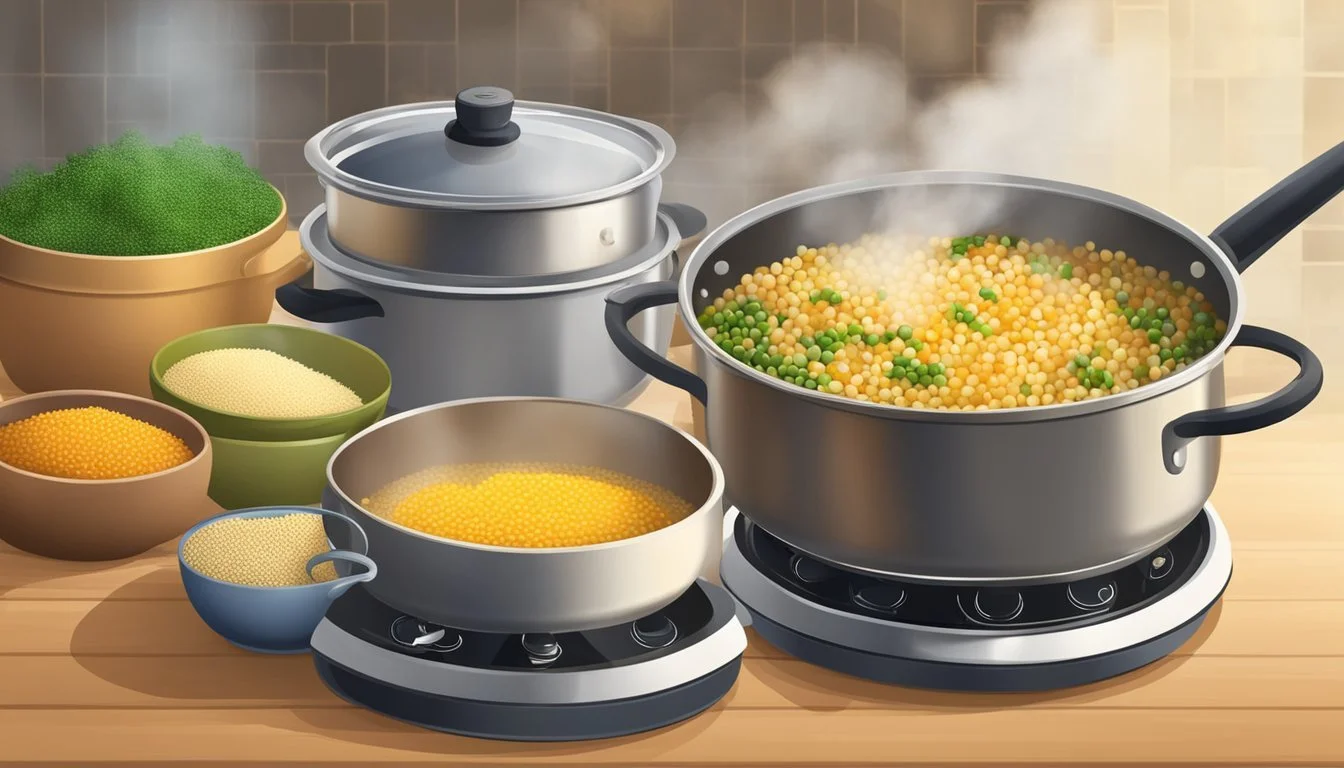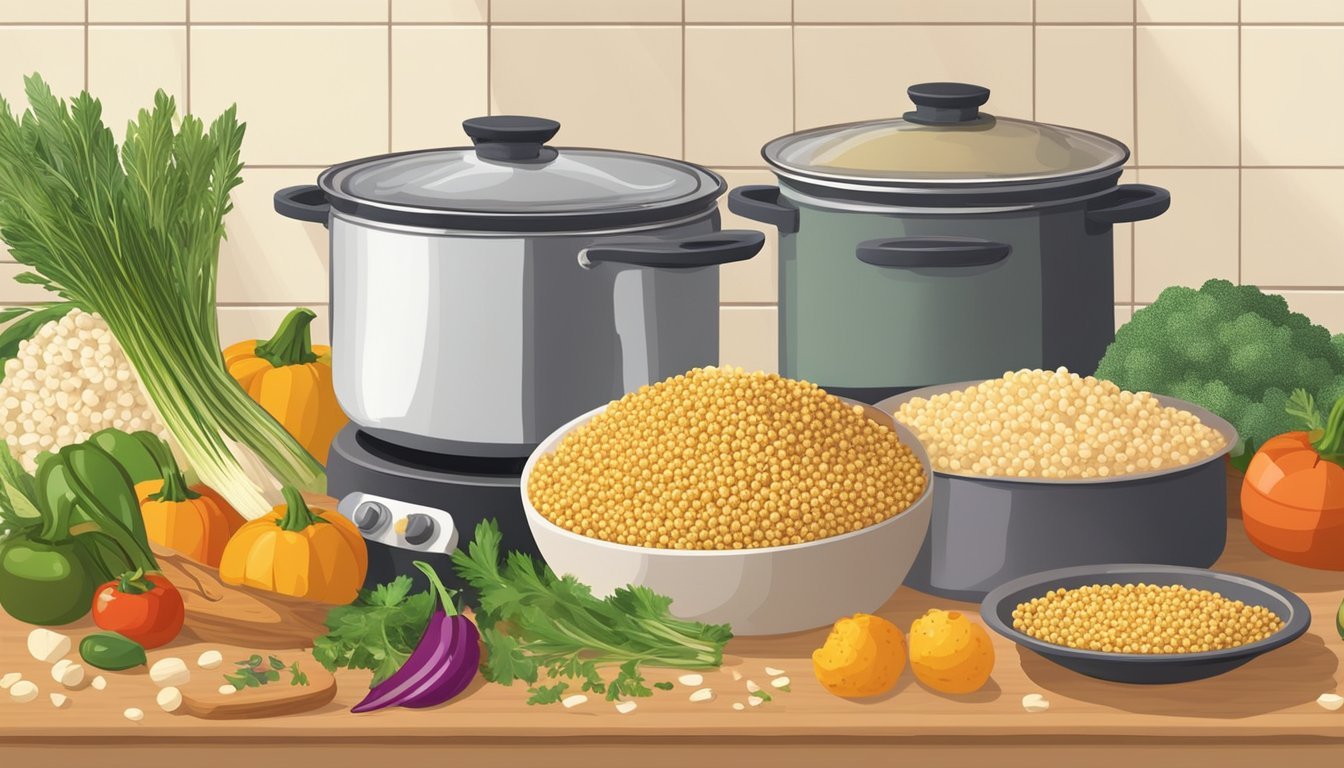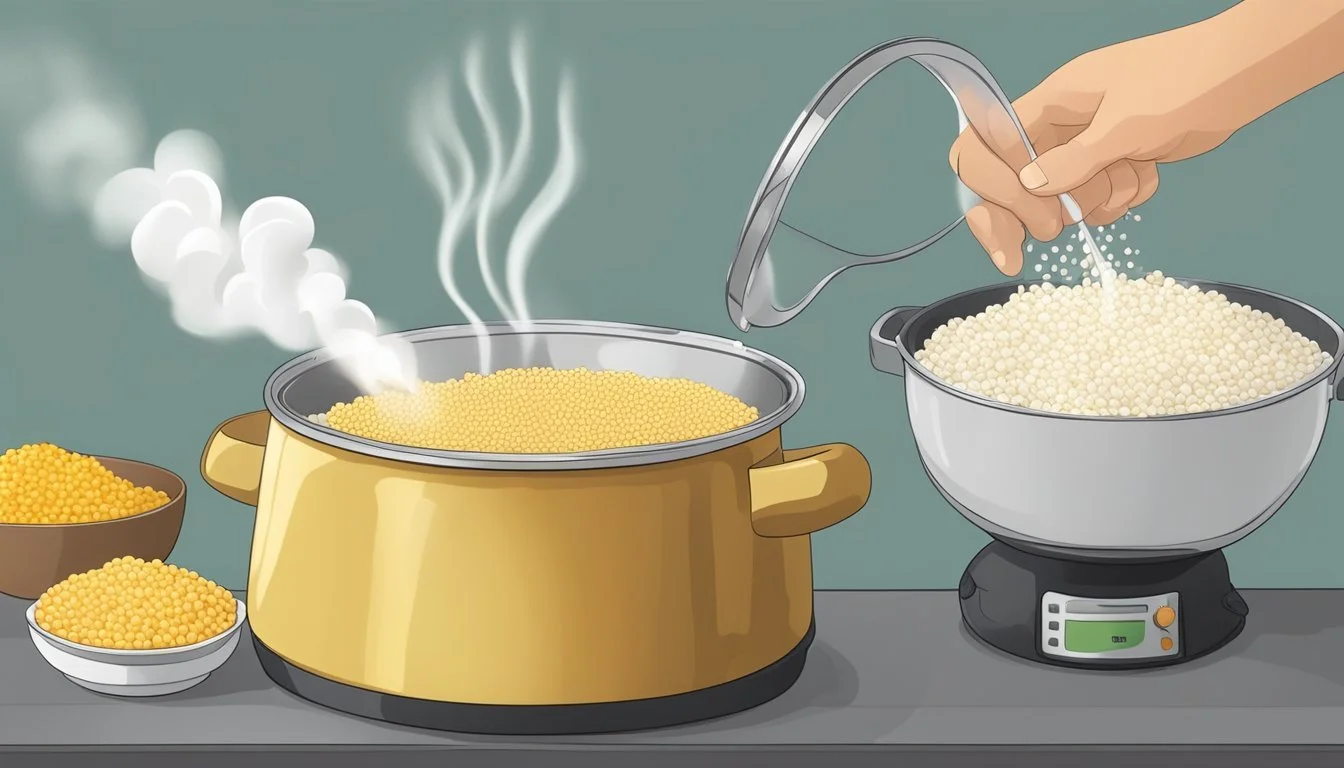How to Cook with Israeli Couscous for Unique Textures
Culinary Techniques Explored
Israeli couscous (What wine goes well with couscous?), also known as pearl couscous, brings a delightful chewiness and unique texture to a myriad of dishes. It originated in the Middle East and is larger than traditional North African couscous, resembling small, round pellets. Unlike its smaller counterpart, Israeli couscous has a slightly chewy texture reminiscent of barley, and it holds up well in both hot and cold dishes, making it a versatile ingredient in the kitchen.
Cooking Israeli couscous involves a process somewhat akin to preparing pasta or rice. Typically, it is first toasted to enhance its nutty flavor before being simmered in water or broth until tender. Due to its robust structure, it absorbs flavors wonderfully without becoming soggy, offering a satisfying mouthfeel ideal for a variety of culinary applications.
As a neutral canvas, Israeli couscous adeptly complements a wide range of ingredients from vibrant vegetables and herbs to rich meats and sauces. Its adaptability in texture and taste allows chefs and home cooks alike to incorporate it into salads, soups, main dishes, or even as a base for a pilaf. The incorporation of Israeli couscous into recipes provides an opportunity to experiment with creating dishes that are both visually appealing and texturally diverse.
What Is Israeli Couscous?
Israeli couscous, also known as "pearl couscous," presents a versatile ingredient renowned for its unique texture in various dishes. This section delves into its origins, key differences from other couscous varieties, and nutritional aspects.
The Origin and Nature of Couscous
Israeli couscous, or ptitim, was developed in the 1950s in Israel as an affordable wheat-based substitute for rice. Unlike Moroccan couscous, which is traditionally small and granular, Israeli couscous consists of larger, pearl-shaped granules. Made from wheat flour and semolina, it's toasted, giving it a distinct, nutty flavor and a robust structure that can withstand more cooking time without losing its characteristic chewiness.
Differences Between Israeli Couscous and Other Varieties
While traditional Moroccan couscous is miniature and light, Israeli couscous has a round, chewy texture reminiscent of pasta. Here are some key distinctions:
Size: Moroccan couscous is fine and small, while Israeli couscous is roughly the size of peppercorns.
Preparation: Moroccan couscous often requires steaming, whereas Israeli couscous is boiled like pasta.
Texture: Israeli couscous offers an "al dente" mouthfeel, suitable for hearty meals and salads.
In culinary applications, Israeli couscous can be compared to pasta grains like orzo or the larger wheat grains in maftoul.
Nutritional Profile of Israeli Couscous
The nutritional profile of Israeli couscous is somewhat similar to that of pasta, as both are made from wheat flour:
Nutrient Per 100g Serving (*approximate values) Calories 350 kcal Protein 12 g Fat 1 g Saturated Fat <0.5 g Fiber 5 g Sodium 10 mg Sugar 4 g Potassium 188 mg Iron 1 mg Calcium 10 mg
While it's not a rich source of vitamins A and C, Israeli couscous can contribute to the intake of fiber and protein in a balanced diet. It has a modest calorie count and contains very little fat and saturated fat. Israeli couscous should be enjoyed as part of a diverse diet with a mindful approach to portion sizes to maintain a healthy nutritional balance.
Selecting Ingredients for Cooking
When cooking with Israeli couscous, selecting high-quality ingredients is paramount. The type of couscous, the herbs and spices used for flavor, and the choice of liquid for cooking all contribute distinctively to the dish's texture and taste.
Choosing the Right Type of Couscous
Israeli couscous, also known as pearl couscous, significantly differs from its smaller North African counterpart. The larger grains provide a chewy texture that perfectly absorbs flavors. One should look for a high-quality brand that ensures uniformity in size for even cooking.
Herbs and Spices That Enhance Couscous
Subtle yet impactful, herbs and spices are transformative. They should be selected based on the desired flavor profile:
Herbs: Fresh parsley, mint, and cilantro lend a vibrant, aromatic touch.
Spices: Ground cinnamon can add warmth and depth.
Incorporation of lemon zest can introduce a bright and zesty note that pairs well with the herbs.
Optimal Liquids for Cooking Couscous
The liquid used to cook the couscous is crucial as it is absorbed by the grains:
Water offers a neutral base.
Stocks: Vegetable or chicken broth can impart additional flavors.
Seasoning: Adding kosher salt to the cooking liquid is critical for properly seasoned grains.
Using extra virgin olive oil in the cooking process can also highlight the couscous's naturally nutty flavor.
Cooking Techniques for Israeli Couscous
Israeli couscous can provide a delightful alternative to traditional grains when prepared correctly. Utilizing techniques like toasting and precise simmering, a chef can elevate the texture and flavor profile of this versatile ingredient.
Toasting for Flavor and Texture
Toasting Israeli couscous in a bit of oil is the initial step for deepening its flavor and achieving a chewy texture. Over medium heat, it typically takes about 5 minutes for the couscous pearls to reach a golden brown color, which indicates that they are adequately toasted. This process not only contributes a nuttier flavor but also prevents the grains from becoming too sticky after cooking.
Toasting Time: Approximately 5 minutes
Method: Stir couscous in heated oil over medium heat
Result: Golden brown couscous with a nutty flavor and chewy texture
Mastering the Simmering Process
After toasting, adding boiling liquid to the couscous begins the simmering process. The liquid ratio is crucial; about 1.25 cups of water or broth per cup of couscous ensures the grains remain fluffy and not waterlogged. The heat must be low enough to maintain a gentle simmer, and the pot should be covered. Simmering allows the pearls to cook uniformly, creating an al dente texture that retains a slight bite.
Liquid Ratio: 1.25 cups of liquid per cup of couscous
Cook Time: Approximately 10-14 minutes
Method: Gentle simmer with the pot covered
Ideal Cooking Times and Temperatures
Cooking Israeli couscous at the right temperature and duration is essential to prevent overcooking. After bringing the liquid to a boil and adding the toasted couscous, reduce the heat and simmer with the lid on. Cooking times can vary, but generally, 10 minutes yields al dente texture whereas 14 minutes will make the couscous tender with all the liquid absorbed. It is important to check the couscous periodically to ensure it does not cook past the desired texture.
Temperature: Low enough for a gentle simmer
Doneness Indicator: Liquid is fully absorbed, couscous is tender
Final Texture: Fluffy and chewy, not mushy
Chef's Tip: After cooking, fluff the couscous with a fork to separate the grains and release steam, allowing the texture to settle perfectly.
Recipes and Variations
Israeli couscous offers a versatile foundation for a variety of dishes, allowing home chefs to explore tastes from Mediterranean to Middle Eastern cuisines. Here are distinct recipes and variations to elevate the use of Israeli couscous in your cooking repertoire.
Classic Israeli Couscous Salad
A staple in Mediterranean cuisine, the classic Israeli couscous salad is refreshing and vibrant. It typically combines Israeli couscous with cucumber, tomato, feta cheese, fresh herbs like dill, lemon juice for brightness, and olive oil as a dressing. It can be enjoyed as a standalone vegetarian salad or with added proteins such as chicken or shrimp for a heartier meal.
Ingredients:
1 cup Israeli couscous
½ cup diced cucumber
½ cup halved cherry tomatoes
⅓ cup crumbled feta cheese
2 tbsp chopped dill
Zest and juice of 1 lemon
2 tbsp olive oil
Salt and pepper to taste
Cook couscous according to package instructions; let it cool.
Mix in vegetables, feta, and herbs.
Combine lemon zest, juice, and olive oil; season the salad.
Inventive Main Dishes with Couscous
Israeli couscous can be the star in main dishes when combined with various proteins and vegetables, offering a delightful substitute to traditional pasta or rice. One can sauté couscous in butter or olive oil with onions and garlic, then simmer it in broth until tender. This giant couscous pairs well with roasted vegetables, spinach,** pesto sauce**, or parmesan, creating a dish that's both satisfying and full of flavor.
Examples:
Couscous with Chicken and Pine Nuts: Toast couscous with onion, add chicken strips, pine nuts, and cook until tender.
Shrimp and Couscous Pesto: Combine cooked couscous with sautéed shrimp and fresh pesto sauce.
Creative Side Dishes
For inventive side dishes, Israeli couscous can be enhanced with raisins, nuts, and a variety of fresh herbs to complement its unique texture. It's also excellent tossed with arugula and parmesan for a simple yet tasteful side, or mixed with roasted butternut squash and olive oil for a vegan option. The grain's adaptability makes it a superb addition to any side, from salads to warm side dishes.
Ideas:
Stir couscous with caramelized onions and raisins; serve with herbs.
Toss couscous with arugula, shaved parmesan, and a lemony dressing.
Serving and Pairing Ideas
Israeli couscous offers a delightful base that complements a multitude of ingredients, thanks to its subtle flavor and pleasing texture. The perfect pairing should create a balance between the mild taste of the couscous and the accompanying flavors and textures.
Combinations with Meats and Vegetables
Meat Pairings:
Chicken thighs (What wine goes well with chicken thighs?): Their juicy texture and rich flavor marry well with the chewiness of Israeli couscous.
Beef kabobs: (What wine goes well with beef kabobs?) The robust taste of grilled beef offers a delectable contrast to the more neutral couscous.
Lamb Bolognese: A hearty sauce with tender lamb complements the couscous' soft pearls.
Vegetable Pairings:
Grilled asparagus: Smoky and tender, asparagus brings a fresh contrast to the dish.
Stuffed bell peppers: Filled with a mix of vegetables and protein, bell peppers and couscous together make for a colorful and filling meal.
Roasted sweet potato: The sweetness and soft texture of roasted sweet potatoes complement the pearl couscous.
Choosing the Right Dressings and Toppings
Dressings: For a simple yet flavorful dressing, combine olive oil, lemon juice, salt and pepper, and fresh parsley. Such dressings coat the couscous evenly, enhancing its flavor without overpowering the dish.
Toppings:
Crumbled feta or goat cheese: Adds a creamy texture and tangy taste that contrasts with the smooth couscous.
Toasted nuts or seeds: Provide a crunchy element that pairs nicely with the couscous' tenderness.
Fresh herbs and spices: Including black pepper, can be sprinkled on top to add bursts of flavor and enhance the overall dish.
Storage and Reheating
Proper storage and reheating techniques are essential to maintaining the unique textures of Israeli couscous. It ensures that couscous remains fluffy and doesn't lose its distinct quality whether it's being enjoyed for lunch the next day or as a reheated dinner.
Best Practices for Storing Cooked Couscous
One should store Israeli couscous in the fridge to preserve its freshness. It is imperative to allow the couscous to cool to room temperature before storage to prevent moisture build-up. For optimal results, store couscous in an airtight container where it can last for up to 4-5 days. When stored correctly, the couscous retains its texture and is ready to be included in any meal as a satisfying leftover.
Reheating for Optimal Taste and Texture
To reheat, one should transfer the couscous into a microwave-safe dish and sprinkle a tablespoon of water per cup to prevent drying out. Cover loosely with a microwave-safe lid or cover. Microwave on high for 1 minute, then fluff with a fork to ensure even warmth and to maintain its fluffy texture. One can also reheat it on the stovetop by simmering with a small amount of water or broth, stirring frequently until it's heated through. This method helps to refresh the texture making it almost as good as when it was first prepared.
Health Considerations and Dietary Adjustments
Israeli couscous, a pasta-like grain, can be a satisfying and versatile addition to many diets. Its unique texture and taste provide a base for a variety of dishes that can suit different nutritional needs and preferences.
How to Incorporate Couscous into a Balanced Diet
Israeli couscous, though not a whole grain, can contribute fiber and carbohydrates to a balanced diet when consumed in moderation. Its mild flavor pairs well with a variety of vegetables, proteins, and legumes, making it suitable for vegetarian and vegan diets. To maximize nutrition, one can:
Combine couscous with legumes such as lentils or chickpeas, which provide additional fiber and protein.
Use it as a base for salads incorporating a rainbow of vegetables to ensure a high intake of vitamins and minerals.
Serve couscous as a side dish to lean proteins like chicken or fish, which are not only healthy but also enhance satiety.
Gluten-Free and Whole Grain Alternatives
For individuals requiring gluten-free alternatives, Israeli couscous made from grains like quinoa or brown rice can be an excellent substitute. Gluten-free couscous options maintain the unique textures while providing the necessary dietary adjustments for those with celiac disease or gluten sensitivity. In addition, these substitutions typically offer:
Whole grain benefits, such as increased fiber, which can aid in digestion and provide a feeling of fullness.
A complete protein source in the case of quinoa-based couscous, containing all nine essential amino acids.
It's important for consumers to check packaging to ensure the alternative couscous products meet their specific dietary needs.
Tips and Tricks for Perfect Couscous Every Time
Cooking Israeli couscous to perfection hinges on mastering both texture and taste. Achieving the desired fluffiness and flavor can transform the dish from mundane to extraordinary.
Troubleshooting Common Cooking Issues
Couscous Too Sticky: If couscous clusters together, it might be overcooked or insufficiently fluffed. Ensuring a quick release of steam after cooking can help maintain separation of grains.
Couscous Too Hard: Undercooking can lead to a tough texture. An adequate ratio of liquid to couscous and appropriate cooking time are crucial; couscous should simmer until tender yet firm.
Couscous Lacking Flavor: Couscous acts like a sponge, absorbing flavors from liquids and seasonings. Using broth instead of water and incorporating spices early on can enhance its taste.
Enhancing Couscous Dishes with Simple Additions
To elevate the culinary experience, consider the following additions:
Nuts for Texture: Mix in toasted pistachios or pine nuts post-cooking for a satisfying crunch.
Fruits for Sweetness: Incorporate dried fruit such as raisins or chopped apricots to add a touch of natural sweetness.
Aromatics for Depth: Sautéed shallot can add a layer of complexity and subtle sharpness.
Cheese for Richness: Crumbled feta contributes a creamy and tangy element, balancing the nutty flavors of couscous.
Seasoning: A mere pinch of salt or custom spice blends tailored to your main dish can immensely boost the flavor profile.
By attentively adjusting these factors, the texture and flavor of Israeli couscous dishes can be optimized for an appetizing and memorable meal.






